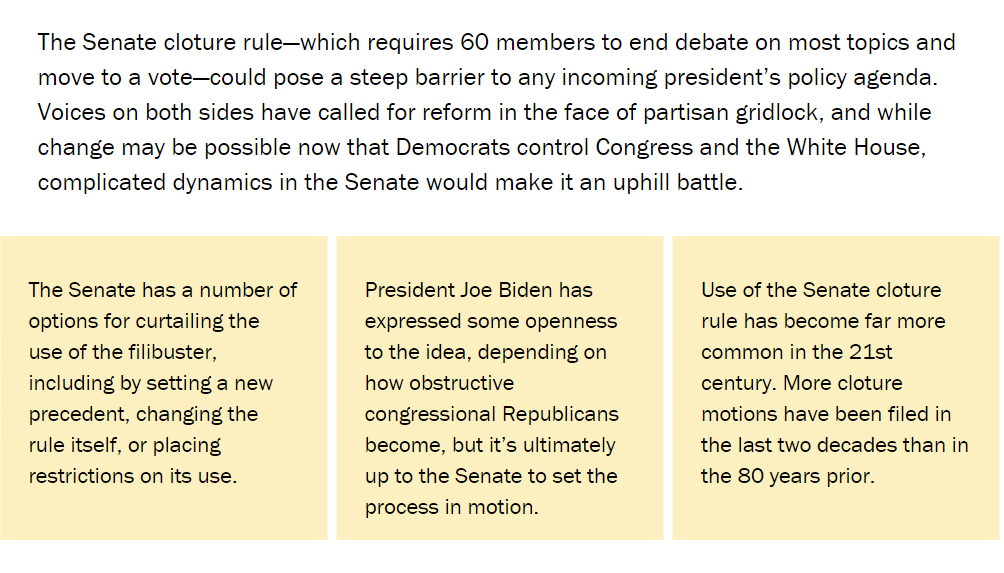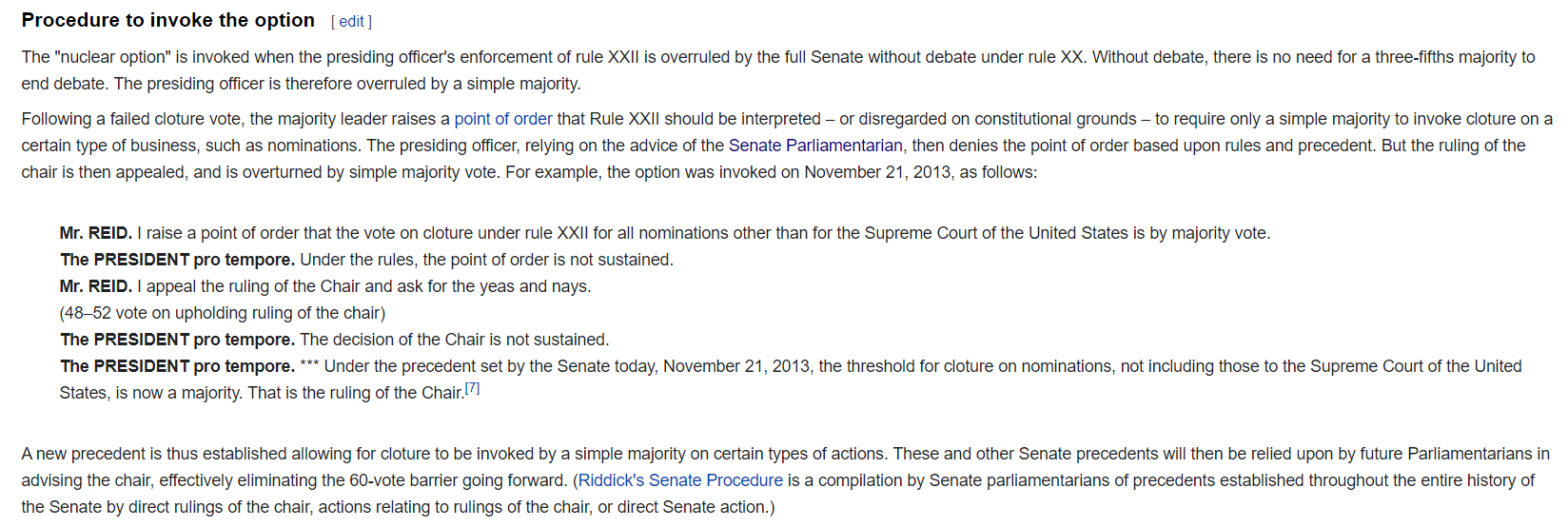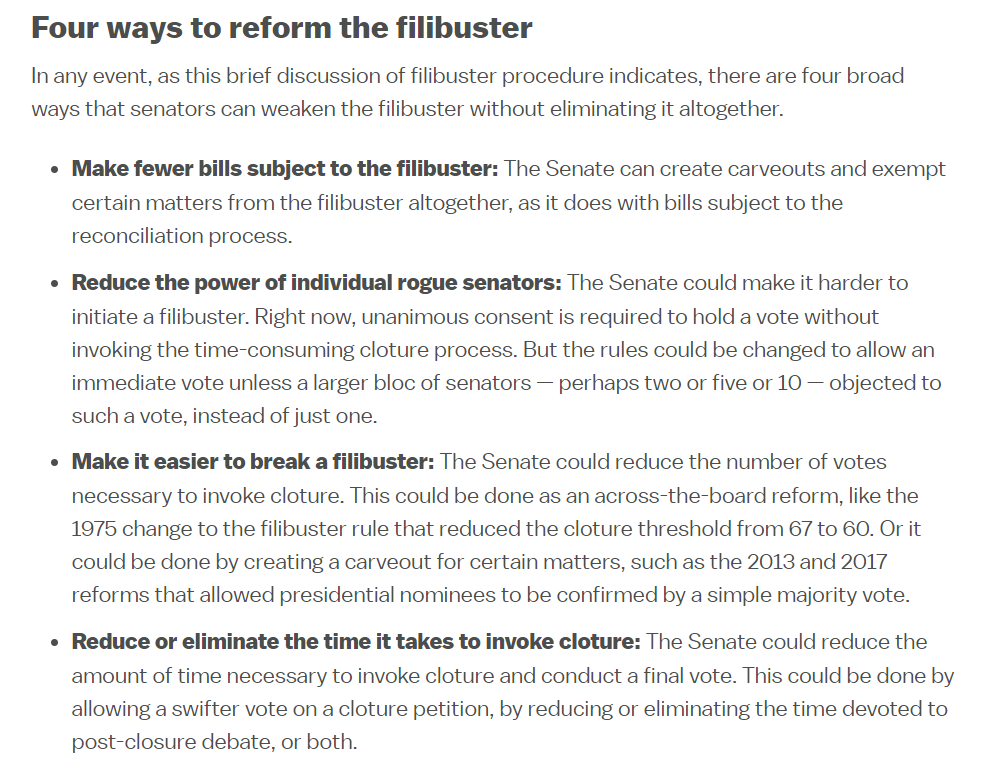General Discussion
Related: Editorials & Other Articles, Issue Forums, Alliance Forums, Region Forumsoptions for filibuster reform
Last edited Mon Mar 8, 2021, 04:58 AM - Edit history (1)
https://www.washingtonpost.com/outlook/2021/03/02/manchin-filibuster-never-sinema/Instead of naming and shaming them, Democrats might consider looking at what Manchin and Sinema like about the filibuster. Sinema recently said, “Retaining the legislative filibuster is not meant to impede the things we want to get done. Rather, it’s meant to protect what the Senate was designed to be. I believe the Senate has a responsibility to put politics aside and fully consider, debate, and reach compromise on legislative issues that will affect all Americans.” Last year, Manchin said, “The minority should have input — that’s the whole purpose for the Senate. If you basically do away with the filibuster altogether for legislation, you won’t have the Senate. You’re a glorified House. And I will not do that.” If you take their views at face value, the goal is to preserve some rights for the Senate minority, with the aim of fostering compromise. The key, then, is to find ways not to eliminate the filibuster on legislation but to reform it to fit that vision. Here are some options:
Make the minority do the work.
Make the minority do the work. Currently, it takes 60 senators to reach cloture — to end debate and move to a vote on final passage of a bill. The burden is on the majority, a consequence of filibuster reform in 1975, which moved the standard from two-thirds of senators present and voting to three-fifths of the entire Senate. Before that change, if the Senate went around-the-clock, filibustering senators would have to be present in force. If, for example, only 75 senators showed up for a cloture vote, 50 of them could invoke cloture and move to a final vote. After the reform, only a few senators in the minority needed to be present to a request for unanimous consent and to keep the majority from closing debate by forcing a quorum call. The around-the-clock approach riveted the public, putting a genuine spotlight on the issues. Without it, the minority’s delaying tactics go largely unnoticed, with little or no penalty for obstruction, and no requirement actually to debate the issue.
One way to restore the filibuster’s original intent would be requiring at least two-fifths of the full Senate, or 40 senators, to keep debating instead requiring 60 to end debate. The burden would fall to the minority, who’d have to be prepared for several votes, potentially over several days and nights, including weekends and all-night sessions, and if only once they couldn’t muster 40 — the equivalent of cloture — debate would end, making way for a vote on final passage of the bill in question.
Go back to the “present and voting” standard.
A shift to three-fifths of the Senate “present and voting” would similarly require the minority to keep most of its members around the Senate when in session. If, for example, the issue in question were voting rights, a Senate deliberating on the floor, 24 hours a day for several days, would put a sharp spotlight on the issue, forcing Republicans to publicly justify opposition to legislation aimed at protecting the voting rights of minorities. Weekend Senate sessions would cause Republicans up for reelection in 2022 to remain in Washington instead of freeing them to go home to campaign. In a three-fifths present and voting scenario, if only 80 senators showed up, only 48 votes would be needed to get to cloture. Add to that a requirement that at all times, a member of the minority party would have to be on the floor, actually debating, and the burden would be even greater, while delivering what Manchin and Sinema say they want — more debate.
Narrow the supermajority requirement.
snip
scarletwoman
(31,893 posts)changed without a two-thirds vote.
Celerity
(43,353 posts)mini nuclear options, to change the restrictions. All it takes is simple majority.
https://www.rules.senate.gov/rules-of-the-senate

https://www.brookings.edu/policy2020/votervital/what-is-the-senate-filibuster-and-what-would-it-take-to-eliminate-it/


scarletwoman
(31,893 posts)Senate rules are negotiated at the start of a new Senate. Subsequent rules changes currently require a two-thirds vote:
https://www.senate.gov/general/Features/votes.htm
Celerity
(43,353 posts)Use logic, if it was not possible, then explain the two previous mini nukes, which were both done mid-session as well (thus removing your 'only at the beginning of the session' incorrect rebuttal). They set new precedents, which are then binding going forward. Rule XX is the instrument that is used.
Also, why would there be dozens (hundreds?) of articles about it, often by by high-powered experts and think tanks if it was impossible (as there is NO chance we will ever get 2/3rds to vote for a traditional rules change) to do?
https://www.vox.com/22260164/filibuster-senate-fix-reform-joe-manchin-kyrsten-sinema-cloture-mitch-mcconnell


scarletwoman
(31,893 posts)unblock
(52,222 posts)They call it the nuclear option because it blows up the rules agreement in place.
But constitutionally, the senate can do anything by majority vote at any point, except for specific things that require more, such as to override a veto.
The senate can't remove its own right to do most things by majority vote. Any rule is only in place until they decide to change it, which can always be done by majority vote.
brush
(53,776 posts)Can they not read? Don't they even know the history of the maneuver they're defending? It's a fucking vestige of slavery, not some revered tool that allegedly elevates the Senate to the "greatest deliberative body in the world." They need to stop bullshiting people. It helps republicans, just as that other antiquated and racist institution, the Electoral College does. I swear to God. Some of these grown-ass, white senators sure play themselves, and then try to play the rest of us.
'Kill Switch' Examines The Racist History Of The Senate Filibuster Adam Jentleson traces the history of the filibuster, which started as a tool of Southern senators upholding slavery and then later became a mechanism to block civil rights legislation.
https://search.yahoo.com/yhs/search?hspart=trp&hsimp=yhs-001&grd=1&type=Y61_F1_148993_102720&p=how+did++the+filibuster+come+about
Hugh_Lebowski
(33,643 posts)I realize they may not be the original, but you could always add some ![]()
Celerity
(43,353 posts)Celerity
(43,353 posts)more careful and catch those things. I have been using this a lot in mid thread replies and it got cocked up in a previous cut n' paste.
![]()